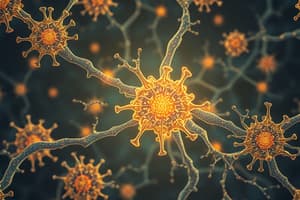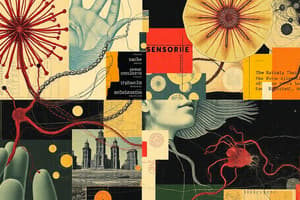Podcast
Questions and Answers
What is the main function of proprioreceptors?
What is the main function of proprioreceptors?
- They sense pain in internal organs.
- They detect changes in temperature.
- They detect the position and movement of the body. (correct)
- They are responsible for the sense of taste.
Which of the following describes the role of interoreceptors?
Which of the following describes the role of interoreceptors?
- They are responsible for detecting light.
- They detect changes in sound waves.
- They sense pressure and touch.
- They detect pain in internal organs. (correct)
What is the primary function of the outer segment of a receptor cell?
What is the primary function of the outer segment of a receptor cell?
- It receives stimuli from the environment. (correct)
- It converts chemical signals into electrical signals.
- It generates energy through mitochondria.
- It transmits action potentials to the brain.
How does a stimulus activate a receptor cell?
How does a stimulus activate a receptor cell?
What is the term used to describe the change in membrane potential of a receptor cell in response to a stimulus?
What is the term used to describe the change in membrane potential of a receptor cell in response to a stimulus?
What happens when the receptor potential reaches the threshold?
What happens when the receptor potential reaches the threshold?
What is the primary role of mitochondria in a receptor cell?
What is the primary role of mitochondria in a receptor cell?
Which of the following is NOT a feature common to most receptor cells?
Which of the following is NOT a feature common to most receptor cells?
What kind of receptor receives information from contact with an external stimulus, such as touch or taste?
What kind of receptor receives information from contact with an external stimulus, such as touch or taste?
Which of the following is NOT a type of sensory receptor classified by energy transduced?
Which of the following is NOT a type of sensory receptor classified by energy transduced?
Which of the following sensory receptors is responsible for detecting changes in temperature?
Which of the following sensory receptors is responsible for detecting changes in temperature?
What type of receptor would be involved in sensing a distant sound, such as a car horn?
What type of receptor would be involved in sensing a distant sound, such as a car horn?
What is the general function of sensory receptors in biophysics?
What is the general function of sensory receptors in biophysics?
What is the relationship between the intensity of a stimulus and the receptor potential?
What is the relationship between the intensity of a stimulus and the receptor potential?
What is the main idea behind Weber-Fechner's law?
What is the main idea behind Weber-Fechner's law?
What is the main contribution of Steven's law to the understanding of stimulus perception?
What is the main contribution of Steven's law to the understanding of stimulus perception?
What is the main purpose of adaptation in sensation?
What is the main purpose of adaptation in sensation?
Which of the following is NOT a characteristic of adaptation?
Which of the following is NOT a characteristic of adaptation?
What does the term 'receptor potential' refer to?
What does the term 'receptor potential' refer to?
According to Weber-Fechner's law, how does the perceived intensity of a stimulus change as its actual intensity increases?
According to Weber-Fechner's law, how does the perceived intensity of a stimulus change as its actual intensity increases?
What is K2 in Steven's Law?
What is K2 in Steven's Law?
Flashcards
Sensory Receptors
Sensory Receptors
Cells that receive and respond to stimuli from the environment or body.
Mechanoreceptors
Mechanoreceptors
Sensory receptors that respond to mechanical pressure or distortion.
Thermoreceptors
Thermoreceptors
Sensory receptors that detect changes in temperature.
Photoreceptors
Photoreceptors
Signup and view all the flashcards
Exteroreceptors
Exteroreceptors
Signup and view all the flashcards
Proprioreceptors
Proprioreceptors
Signup and view all the flashcards
Receptor Structure
Receptor Structure
Signup and view all the flashcards
Receptor Potential
Receptor Potential
Signup and view all the flashcards
Depolarization
Depolarization
Signup and view all the flashcards
Action Potential
Action Potential
Signup and view all the flashcards
Threshold
Threshold
Signup and view all the flashcards
Ion Channels
Ion Channels
Signup and view all the flashcards
Weber-Fechner Law
Weber-Fechner Law
Signup and view all the flashcards
Stevens' Law
Stevens' Law
Signup and view all the flashcards
Intensity of Stimulus (Is)
Intensity of Stimulus (Is)
Signup and view all the flashcards
Sensation Intensity (Ip)
Sensation Intensity (Ip)
Signup and view all the flashcards
Adaptation
Adaptation
Signup and view all the flashcards
Pain Sensation
Pain Sensation
Signup and view all the flashcards
Proportionality Constants
Proportionality Constants
Signup and view all the flashcards
Study Notes
Sensory Receptors
- Sensory perception involves receiving and interpreting information from both the internal (e.g., movement, pain) and external (e.g., vision, hearing) environments.
- Receptors act as energy transducers, converting various forms of energy into signals the body can understand.
Types of Sensory Receptors
-
Classification by energy type:
- Mechanoreceptors: respond to mechanical pressure or distortion
- Thermoreceptors: respond to temperature changes
- Photoreceptors: respond to light
-
Classification by complexity:
- Free nerve endings: simple structures, often involved in pain and temperature detection
- Sensory bodies (or encapsulated nerve endings): more complex structures with specialized coverings, frequently involved in touch and pressure
- Sensory cells: cells specialized for particular sensory functions (e.g., taste, smell)
-
Classification by location of stimuli:
- Exteroreceptors: receive stimuli from outside the body (e.g., touch, sight, hearing)
- Interoreceptors: receive stimuli from within the body (e.g., pain in internal organs)
- Proprioreceptors: receive info about body position and movement (e.g., muscles, tendons)
- Telereceptors: detect stimuli from a distance (e.g., sight, hearing, smell)
Receptor Cells and Their Features
- Sensory receptors consist of two segments: an outer segment, which receives the stimulus, and an inner segment with mitochondria responsible for energy production.
- When a stimulus activates the outer segment, ion channels open or close, causing changes in membrane potential in the cell. This change, called receptor potential, is a graded potential.
- If the receptor potential reaches a threshold level, it triggers an action potential.
- The intensity of the stimulus is directly proportional to the magnitude of the receptor potential and the frequency of action potentials.
Weber-Fechner and Steven's Law
- Weber-Fechner Law: Stimulus intensity and sensation intensity are not directly proportional. A larger change in the stimulus is required to detect a difference in sensation as stimulation levels increase.
- Stevens' Law: The relationship between stimulus intensity and perceived intensity of a sensation is not linear but follows a power law. This means that perceived magnitude increases at a slower rate than the intensity of the stimulus.
- Adaptation: Receptors can adapt, meaning their sensitivity to a constant stimulus decreases over time. Different sensory systems exhibit different levels of adaptation (e.g., pain receptors adapt slowly).
Studying That Suits You
Use AI to generate personalized quizzes and flashcards to suit your learning preferences.



